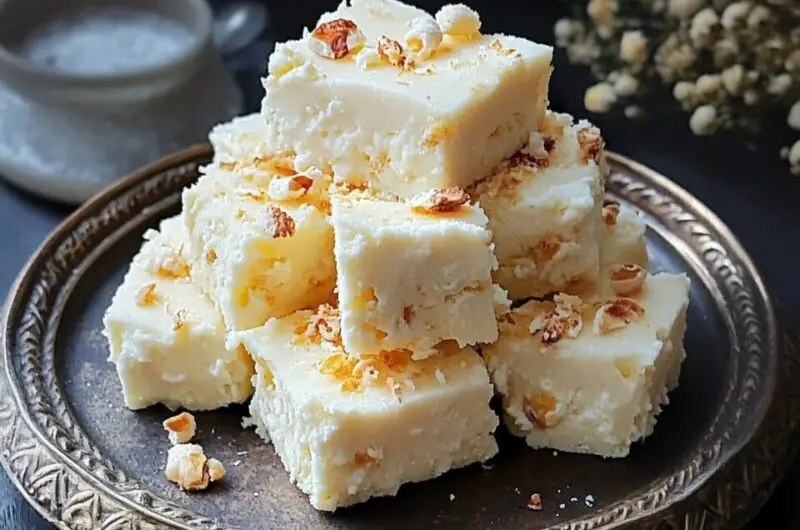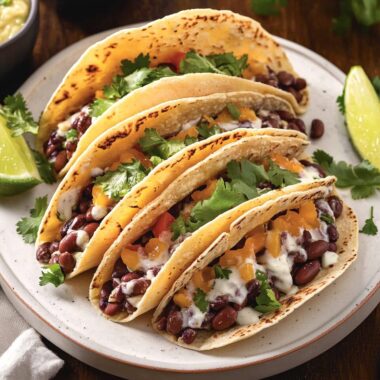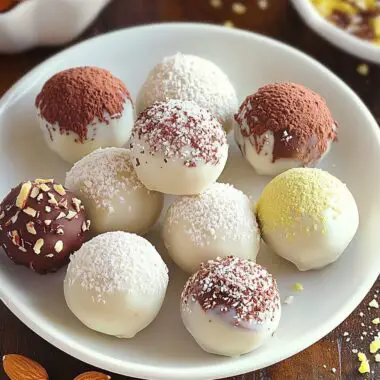The Ricotta Cheese Kalakand is a delicious twist on a traditional Indian sweet made easier for the modern kitchen. By using creamy ricotta cheese and sweetened condensed milk, you can achieve the same luxurious texture and flavor of classic kalakand without hours of stirring or waiting for milk to reduce. Perfect for festive occasions, potlucks, or late-night cravings, this sweet treat comes together in just about 30 minutes. The subtle floral notes of cardamom and rose water elevate its flavor, while chopped pistachios and saffron add a gorgeous pop of color and crunch. Whether you’re celebrating Diwali or simply looking to impress guests with a fusion dessert, this recipe will quickly become a favorite.
Full Recipe:
Ingredients:
-
15 oz whole milk ricotta cheese (1 container)
-
1 can (14 oz) sweetened condensed milk
-
1/2 teaspoon ground cardamom
-
1 tablespoon ghee (optional, for flavor)
-
1 tablespoon rose water (optional)
-
1/4 cup chopped pistachios
-
A few strands of saffron (optional, for garnish)
Directions:
-
In a non-stick or heavy-bottomed pan, combine the ricotta cheese and condensed milk.
-
Mix well and turn on the heat to medium.
-
Stir the mixture continuously for about 20–25 minutes until it thickens and leaves the sides of the pan.
-
Add cardamom powder, ghee (if using), and rose water. Mix well.
-
Turn off the heat and immediately transfer the mixture to a greased or parchment-lined square or rectangular dish.
-
Spread it evenly and top with chopped pistachios and saffron.
-
Let it cool completely at room temperature or refrigerate until firm.
-
Cut into squares and serve chilled or at room temperature.
Prep Time: 5 minutes | Cooking Time: 25 minutes | Total Time: 30 minutes
Kcal: 210 kcal per piece (approx.) | Servings: 12 pieces
The Magic of Ricotta Kalakand – A Modern Take on a Classic Indian Sweet
Indian sweets hold a special place in the heart of every dessert lover, especially during festive seasons. Among these, Kalakand is one of the most cherished milk-based desserts in Indian cuisine. Traditionally slow-cooked and labor-intensive, this dish gets a delightful and efficient upgrade with the use of ricotta cheese a modern kitchen twist that maintains authenticity while saving time.
In this article, we’ll explore the beauty of Ricotta Cheese Kalakand, its cultural significance, how it compares to the traditional version, useful tips for perfect results, serving and storage ideas, and some creative variations you can try.
What is Kalakand?
Kalakand is a classic Indian mithai (sweet) made by reducing milk to form a moist, grainy-textured sweet that’s gently flavored with cardamom and topped with nuts like pistachios or almonds. It originated in northern India and is a staple during festivals such as Diwali, Raksha Bandhan, and Holi. Its rich yet subtly sweet flavor, coupled with its melt-in-your-mouth texture, makes it an all-time favorite.
Traditional Kalakand is made by simmering milk for hours, followed by the addition of a curdling agent to make chenna (fresh cheese), which is then cooked further with sugar to form a dense, slightly crumbly sweet. While delicious, this method can be time-consuming something today’s busy kitchens often can’t accommodate.
Why Use Ricotta Cheese for Kalakand?
Ricotta cheese is an Italian cheese known for its soft, creamy, and grainy texture remarkably similar to the texture of Indian chenna or paneer when lightly cooked. Because it’s already curdled and drained, ricotta becomes a perfect shortcut ingredient that cuts down hours of labor into just 30 minutes without compromising flavor or texture.
Using ricotta cheese in Kalakand:
-
Saves time: No need to curdle milk or cook it down.
-
Simplifies the process: Fewer steps, fewer utensils, and less mess.
-
Delivers authentic taste: The texture and richness mirror the traditional version.
-
Accessible ingredients: Ricotta is readily available in most supermarkets across the globe.
Flavor Profile and Texture
Ricotta Kalakand is known for its soft, moist, and slightly grainy texture a delightful contrast to many other Indian sweets that tend to be firmer or syrup-soaked. The flavor is subtle, milky, and infused with aromatic cardamom, which elevates its delicateness.
Often topped with slivers of pistachio or almonds and sometimes a few saffron strands, Ricotta Kalakand not only tastes great but also looks elegant and festive.
Perfect for Festivals and Special Occasions
Whether it’s Diwali, Eid, Navratri, or a simple family get-together, Ricotta Kalakand adds a festive flair to the dining table. It’s a great choice for last-minute desserts when you want something homemade, traditional, and impressive without spending hours in the kitchen.
Hosting guests or contributing to a potluck? A box of neatly cut Kalakand squares wrapped in parchment or decorative boxes makes a heartfelt, delicious gift.
Tips for Best Results
To get the most out of your Ricotta Kalakand, consider the following tips:
-
Use full-fat ricotta cheese for the richest flavor and creamiest texture.
-
Cook the mixture on medium to low heat, stirring regularly to prevent it from sticking or burning.
-
Don’t overcook once the mixture thickens and starts leaving the sides of the pan, it’s ready to be set.
-
Adding a teaspoon of ghee enhances the traditional flavor, though it’s optional.
-
For added floral aroma, a touch of rose water or kewra water works beautifully.
-
Set it in a square or rectangular dish and cool completely before slicing for clean, sharp edges.
Variations You Can Try
Ricotta Kalakand is highly adaptable and open to personalization. Here are a few creative twists:
1. Chocolate Kalakand
Add 2 tablespoons of unsweetened cocoa powder or melted dark chocolate to the mixture before setting. A layer of chopped nuts on top makes it extra indulgent.
2. Fruit-Flavored Kalakand
Add mango puree, rose syrup, or strawberry essence to give it a fruity twist. These are great for themed celebrations or to suit personal preferences.
3. Nuts and Dry Fruits Mix
Stir in chopped cashews, almonds, or raisins into the mixture before setting for extra texture and a nutritional boost.
4. Vegan Kalakand
Use plant-based condensed milk and vegan ricotta or tofu for a dairy-free version. While the taste will differ slightly, it’s still a delicious option.
Cultural Significance of Kalakand in Indian Celebrations
Kalakand is more than just a dessert it’s part of India’s culinary heritage. Originating from the town of Alwar in Rajasthan, it’s a sweet that’s often associated with celebration, joy, and auspicious beginnings. Traditionally prepared in homes during festivals like Diwali, Janmashtami, Raksha Bandhan, and Holi, it’s also offered in temples and used as prasad (holy offering).
Because of its association with milk a sacred ingredient in Hindu rituals Kalakand symbolizes purity and abundance. It’s commonly seen in Indian households during:
-
Weddings and engagements, as part of the sweets platter.
-
Religious ceremonies, where it’s offered to deities.
-
Birthdays and baby showers, signifying sweetness and prosperity.
In modern times, Ricotta Cheese Kalakand provides an easy way for Indian families abroad to stay connected with these traditions without needing access to local dairy or spending hours in the kitchen.
Health Aspects and Nutritional Benefits
Although Kalakand is considered an indulgent treat, the ricotta version offers a slightly healthier twist compared to traditional recipes, thanks to its simplified ingredient list and reduced cooking time (which helps preserve more nutrients).
Here’s why this dessert can be considered a more mindful indulgence:
-
Protein-rich: Ricotta cheese contains a good amount of protein and calcium, both important for muscle and bone health.
-
Lower sugar option: You can control the amount of sugar added, or even substitute it with natural sweeteners like stevia or coconut sugar.
-
Fewer preservatives: Homemade sweets like this are free from additives, emulsifiers, or artificial flavorings that many store-bought desserts contain.
-
Portion control: It’s easy to cut into small squares, making portion control simple.
That said, moderation is key. As with all sweets, enjoy it as part of a balanced lifestyle, especially if you’re managing calorie intake or blood sugar levels.
What Pairs Well with Kalakand?
Kalakand is typically enjoyed on its own, but pairing it creatively can elevate the experience even more. Consider these pairings:
Beverages:
-
Masala Chai: The spice of chai balances the sweetness.
-
Cardamom Coffee: A strong brew with a hint of cardamom complements the rich flavor.
-
Chilled Milk or Rose Lassi: Light, cooling beverages contrast the dense texture.
Accompaniments:
-
Fresh Berries or Sliced Mango: The tartness of fruits balances the creamy sweetness.
-
Roasted Nuts: Add extra crunch and texture contrast.
-
Lightly sweetened Greek yogurt: For a fusion-inspired dessert bowl.
Serving Kalakand as part of a dessert platter with gulab jamun, kheer, or rasmalai can also make for a beautiful and indulgent Indian sweet spread for festive dinners or weddings.
Conclusion:
Ricotta Cheese Kalakand is a beautiful example of culinary evolution, where traditional recipes are reimagined with modern, globally available ingredients. It preserves the soul and sentiment of Indian cooking while embracing the convenience that contemporary lifestyles demand.
Whether you’re cooking for a celebration, gifting sweets to loved ones, or simply craving a nostalgic dessert, this version of Kalakand will not disappoint. With just a few ingredients and minimal effort, you’ll create a sweet that’s elegant, soulful, and crowd-pleasing.
So, next time you’re thinking of something special yet simple to make reach for that tub of ricotta, your favorite condensed milk, and some aromatic cardamom and let the magic of Kalakand unfold in your kitchen.








